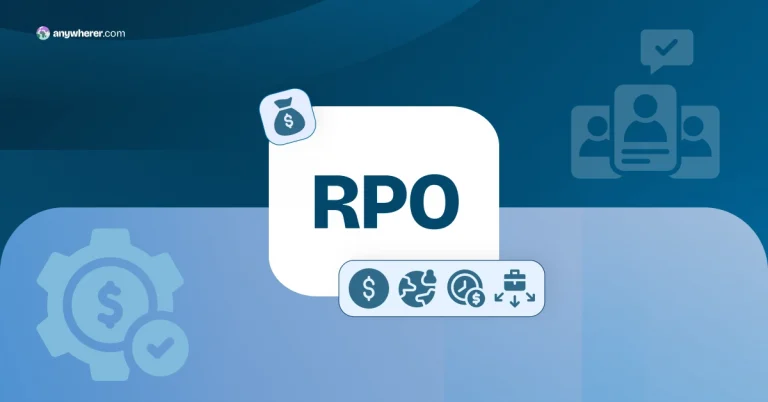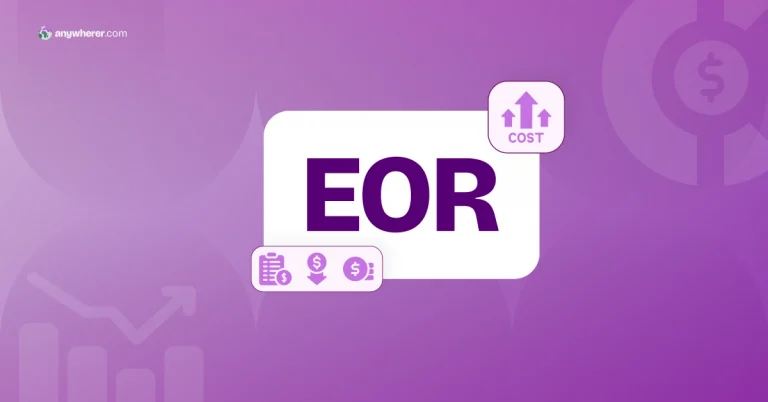Rising operational complexity and the shift toward distributed workforces drive demand for efficient solutions to tackle fast-changing labor laws and scale efficiently. Hence, there is a growing interest in services like ASO (Administrative Services Organization) — especially among businesses looking to scale without the burden of building large internal HR teams.
So, what is ASO, and is it a cost-effective option for your business? Let’s explore.
Introducing the ASO Model and ASO Costs
ASO model allows companies to achieve numerous other benefits, such as:
- Faster scalability across regions and teams.
- Access to specialized HR expertise without building an internal department.
- Lower risk of non-compliance or administrative errors.
- More time for leadership to focus on growth and culture.
ASO Definition
Administrative Services Organization is a flexible HR outsourcing model where a third-party provider handles key administrative tasks while the client company retains complete control over employment relationships.
Meanwhile, like any other service, the ASO model comes with its costs. So, do these expenses justify the value this service delivers in the long run? Let’s find out.
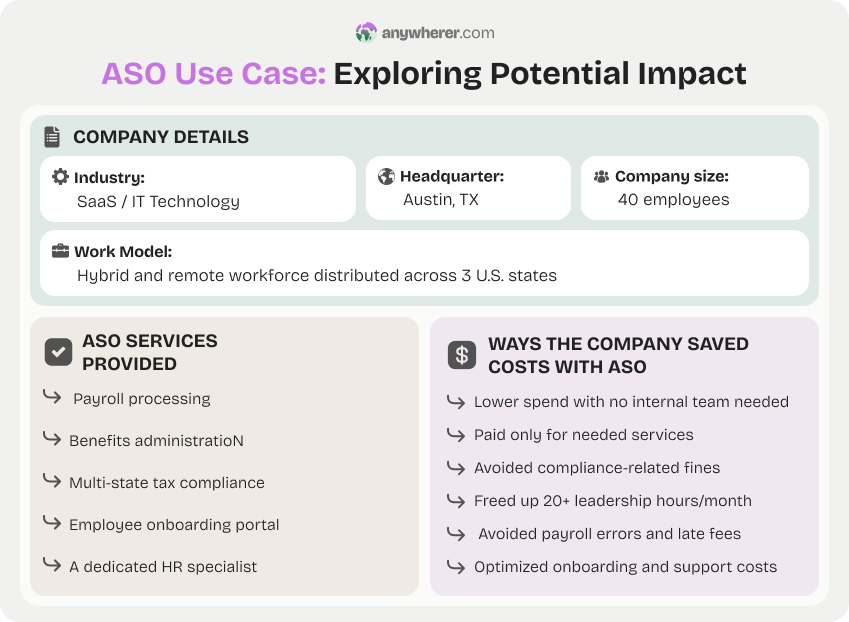
Factors Influencing ASO Prices
ASO costs can vary widely — depending on specific business needs, structure, and growth plans, to name a few. In this section, we’ll break down the key factors.
Scope of services
The services within your ASO agreement are a primary driver of cost. Commonly, as the scope expands, so does the administrative effort — and thus, overall pricing, too.
To better understand how they typically relate to pricing levels, the table below illustrates a breakdown of the most common ASO services.

Level of customization
Since ASO providers must allocate extra time, technology, and personnel to deliver and maintain these custom components, any additional customizations typically come at an added cost — including both one-time setup fees and higher monthly charges for maintaining pre-set customizations.
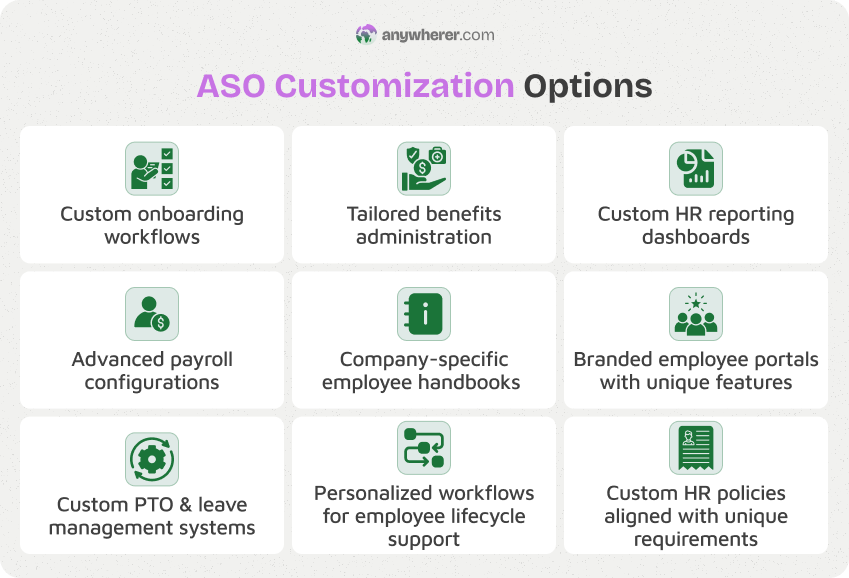
Industry risk or complexity
Highly regulated industries often need specialized expertise, detailed reporting, and compliance support — which increases administrative workload and, thus, service fees. Review a few examples below illustrating this case.
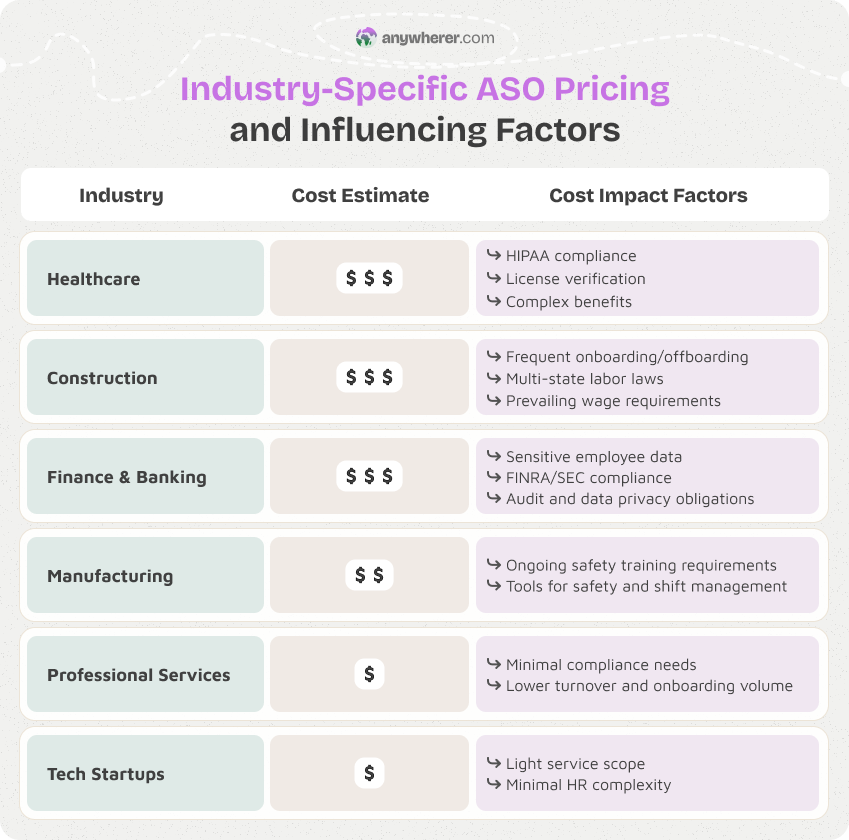
Other Factors Contributing to ASO Costs
In addition to the most common factors mentioned above, the following aspects can also significantly impact your final ASO costs:
- Number of employees — as businesses grow, more employees mean higher total costs, but they are often offered volume discounts.
- Geographic сoverage — since multiple-state operations require extra effort due to differing tax laws, filing deadlines, and compliance requirements.
- Technology access — for advanced HR tools like self-service portals or real-time reporting some ASOs charge extra (a certain fixed fee per employee/month).
- Contract length — longer contracts often mean lower rates as a reward for long-term cooperation.
ASO Pricing Models Explained
Apart from the above-mentioned factors, there’s another crucial element impacting ASO cost — the pricing model. Let’s take a closer look at how much these models can vary.
Per-Employee Per-Month (PEPM) Fees
Example: $50–$100 per employee per month for HR admin, payroll, and compliance support.
With tis model, businesses pay a fixed monthly fee for each employee covered under the ASO services. This makes it ideal for companies that want predictable costs tied to headcount.
Flat Monthly Fees
Example: $1,500 per month for up to 25 employees, including payroll processing and benefits management.
This approach is common for small to mid-sized companies that want simplicity and precise cost control — since it allows them to pay a consistent monthly rate for a defined bundle of services, regardless of headcount (up to a certain pre-agreed threshold).
Tiered Pricing
Example: $60/employee for 1–50 employees, $45/employee for 51–200 employees.
Tiered pricing implies the following: the more employees you have, the lower the per-employee rate typically becomes. This can be particularly benefitial for fast-growing companies.
Custom/À La Carte Pricing
Example: $30/employee for payroll only, $20/employee for benefits administration.
Some ASO providers offer modular pricing based on the services selected. This way, businesses can mix and match services efficiently, thus paying only for what they use.
Hidden ASO Fees to Watch for
Not all ASO costs are visible from the start. Additional fees can appear later, especially as your workforce grows or your HR needs become more complex. See the potential hidden expenses below.
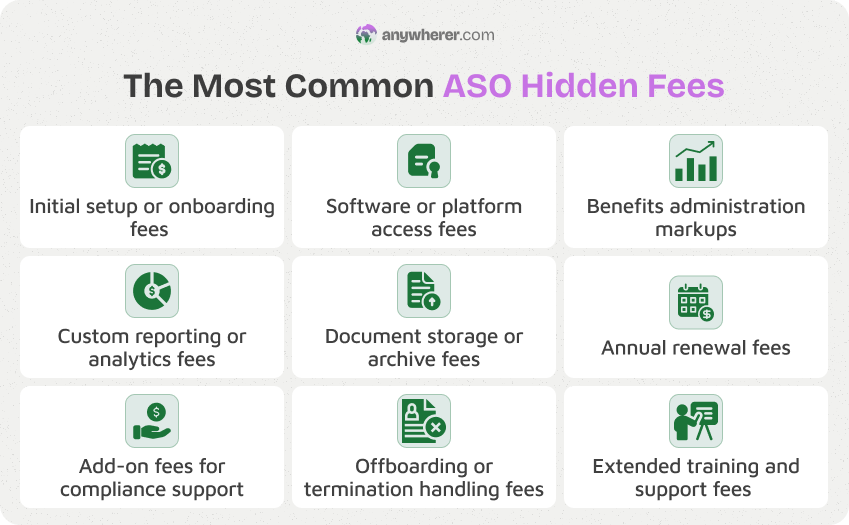
Best Practices for ASO Rates Transparency and Avoiding Hidden Expenses
- Request a cost scenario forecast. Ask for a full breakdown of what’s included in your ASO plan and pricing examples based on your projected headcount over the next 12–24 months to understand how fees may scale.
- Prevent cost overruns with usage thresholds. Agree on fee thresholds that, once hit, pause or notify you before additional charges apply.
- Discuss renewal and exit terms. Scrutinize every detail — annual renewal fees, offboarding charges, penalties for early termination, etc.
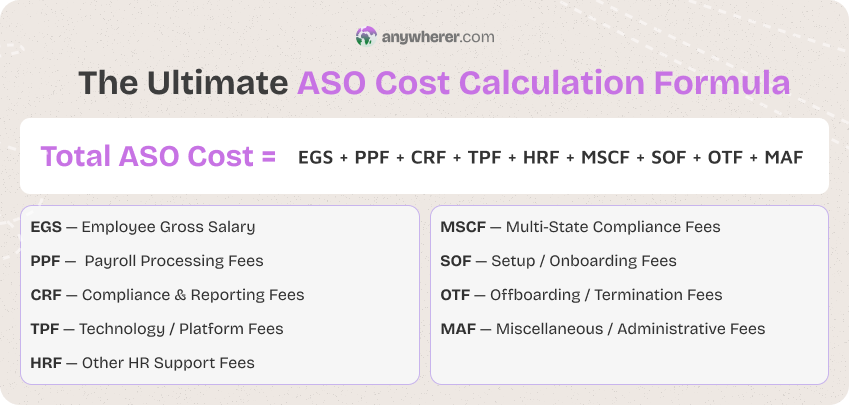
How to Ensure a Full ASO Fee Breakdown: Key Questions to Ask
All things considered, understanding the real cost of ASO services requires a thorough investigation. Use the questionnaire below to ask your ASO partner the right questions — and make an informed, cost-effective choice.
FAQs on ASO Rates and Cost Efficiency
Can ASO pricing be customized for specific business needs?
Yes, many ASO providers offer flexible pricing with à la carte options or bundles, so you only pay for the services your business needs.
How do company size and employee count affect ASO pricing?
As your team grows, providers may offer tiered pricing or volume discounts. Smaller teams may pay higher PEPM rates but still save by avoiding an in-house HR team.
How can businesses evaluate if ASO is cost-effective for them?
Compare ASO fees to in-house HR costs — including salaries, software, and compliance risks. If it saves time and reduces legal exposure, ASO is likely the more efficient choice.
Are ASO models more cost-efficient than traditional health insurance plans?
ASOs don’t replace health insurance providers, but they often manage and administer benefits on your behalf. While medical ASO fees are the same compared to traditional health insurance plan, ASO providers often negotiate better group rates — leading to indirect cost savings on ASO fee insurance.
How can a business estimate its ASO expenses before signing a contract?
Request a detailed quote with service breakdowns, setup fees, and growth-based projections. Also, don’t forget to clarify any hidden or variable costs.
Find out whether ASO cost makes cooperation with Administrative Services Only provider a worthwhile investment for your business.

Yaryna is our lead writer with over 8 years of experience in crafting clear, compelling, and insightful content. Specializing in global employment and EOR solutions, she simplifies complex concepts to help businesses expand their remote teams with confidence. With a strong background working alongside diverse product and software teams, Yaryna brings a tech-savvy perspective to her writing, delivering both in-depth analysis and valuable insights.


